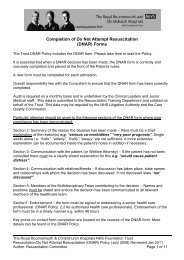View June's Board Pack - Royal Bournemouth Hospital
View June's Board Pack - Royal Bournemouth Hospital
View June's Board Pack - Royal Bournemouth Hospital
- No tags were found...
You also want an ePaper? Increase the reach of your titles
YUMPU automatically turns print PDFs into web optimized ePapers that Google loves.
Where next for the NHS reforms in England?The integration of care can take on many different forms.A distinction can be drawn between real integration, inwhich organisations merge their services, and virtual orcontractual integration, in which providers work togetherthrough networks and alliances. Studies have shown thatorganisational mergers do not deliver benefits withoutclinical and service integration. Virtual integration basedon networks and alliances may therefore offer greaterpotential to deliver a new model of care if it facilitatesclinical teams to come together to co-ordinate servicesaround the needs of patients.In some cases integration may entail bringing togetherresponsibility for commissioning and provision. This formof integration is important because it allows cliniciansto use budgets either to provide services more directlyor to commission these services from others through‘make or buy’ decisions. Many integrated medical groupsin the United States work in this way, and researchhas highlighted the beneficial impact on both serviceutilisation (for example, reduced use of hospital beds)and quality of care. One of the challenges for theproposed reforms is how to facilitate the emergenceof integrated medical groups able to take ‘make or buy’decisions and we discuss this in more detail below.Examples of integration can be found at the micro levelin the use of multidisciplinary teams to meet the needsof individual service users and carers. They can also befound at the meso level when providers collaborate ormerge to meet the needs of particular care groups likeolder people or populations with the same diseases orconditions. The most ambitious forms of integrationare those that provide the full range of care to thepopulations they serve.Kaiser Permanente in the United States is a well-knownexample, and it exhibits many of the elements of the newmodel of care described above. It is a virtually integratedsystem in which hospitals, the medical group and thehealth plan (or ‘commissioner’ to use NHS terminology)remain distinct organisations and collaborate closely.Kaiser Permanente delivers good outcomes for itsmembers, with studies showing that it makes much lessuse of hospital beds than the NHS. It achieves this resultbecause of its focus on prevention, supported self-care,and pro-active care co-ordination (Feachem et al 2002;Ham et al 2003).Integrated care in the NHSIn the NHS, integrated care is particularly important in meetingthe needs of people with chronic diseases like diabetes andchronic obstructive pulmonary disease; frail older people whomay have several chronic diseases and be in contact with arange of health and social care professionals; and people usingspecialist services – for example, those involved in cardiac andcancer care – where networks linking hospitals that providethese services have contributed to improved outcomes. Thefollowing box illustrates examples of each .Diabetes care in BoltonThe Bolton Diabetes Centre was set up in 1995 and is thebase for a team of community-based specialists. The teamreaches into the local hospital for inpatient care, and out togeneral practices to provide support and undertake sharedconsultations. The vision is of care that is patient centredand delivered in the appropriate place at the appropriatetime by the appropriately trained professional. Boltonaspires to develop a fully integrated diabetes servicewithout gaps or duplication and with smooth and quickreferral from primary care to specialist advice. Patientsand staff have reported high levels of satisfaction withthe service, and in 2005/6 Bolton reported the lowestnumber of hospital bed days per person with diabetes inthe Greater Manchester area (Irani et al 2007).Care for older people in TorbayHealth and social care for older people in Torbay isdelivered through integrated teams, first establishedon a pilot basis in 2004 and since extended throughoutthe area. Each team serves a locality of between 25,000and 40,000 people and is aligned with the generalpractices in the locality. Budgets are pooled and areused flexibly by integrated teams who are involved inmicro commissioning to meet patients’ needs. A majorpriority has been to increase spending on intermediatecare services that enable patients to be supported athome and help avoid inappropriate hospital admissions.The work of integrated teams has been taken forwardthrough the work of the Torbay Care Trust, created in2005. Results include a reduction in the daily averagenumber of occupied beds from 750 in 1998/9 to 502 in2009/10, emergency bed day use in the population aged65 and over that is the lowest in the region, and negligibledelayed transfers of care (Thistlethwaite 2011).6 © The King’s Fund 2011
















